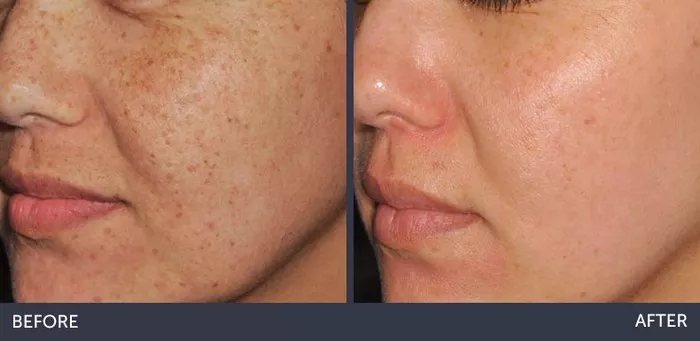Microdermabrasion and chemical peels are two popular cosmetic procedures that are used to improve the appearance of skin. Both procedures are designed to exfoliate the skin and remove dead skin cells, revealing smoother, more youthful-looking skin underneath. While both procedures can be effective, they work in different ways and may be better suited for different skin types and concerns. In this article, we will explore the question of which is better: microdermabrasion or chemical peel. We will discuss the differences between the two procedures, the benefits and risks of each, and help you determine which one may be right for you.
What is Microdermabrasion?
Microdermabrasion is a non-invasive cosmetic procedure that uses a machine to exfoliate the outermost layer of skin. The machine uses tiny crystals or a diamond-tipped wand to remove dead skin cells and improve the texture and appearance of the skin. Microdermabrasion is typically used to improve the appearance of fine lines, wrinkles, age spots, and acne scars.
Microdermabrasion is a relatively quick and painless procedure that typically takes less than an hour to complete. Most people require multiple treatments to achieve the desired results.
What is a Chemical Peel?
A chemical peel is a cosmetic procedure that uses a chemical solution to exfoliate the skin and remove dead skin cells. The solution is applied to the skin and left on for a period of time, depending on the strength of the peel. Chemical peels can be used to improve the appearance of fine lines, wrinkles, age spots, acne scars, and other skin imperfections.
Chemical peels come in different strengths, ranging from mild to deep. Mild peels are typically used to improve the texture and appearance of the skin, while deep peels are used to treat more severe skin conditions.
Differences Between Microdermabrasion and Chemical Peel
While both microdermabrasion and chemical peels are designed to exfoliate the skin and remove dead skin cells, there are some key differences between the two procedures.
Method of Exfoliation: Microdermabrasion uses a machine to physically exfoliate the skin, while chemical peels use a chemical solution to exfoliate the skin.
Depth of Exfoliation: Microdermabrasion exfoliates the outermost layer of skin, while chemical peels can penetrate deeper into the skin, depending on the strength of the peel.
Skin Type: Microdermabrasion is suitable for most skin types, while chemical peels may not be recommended for people with very sensitive skin.
Recovery Time: Microdermabrasion has a quick recovery time, with most people returning to their normal activities immediately after the procedure. Chemical peels may require a longer recovery time, depending on the strength of the peel.
Benefits and Risks of Microdermabrasion
Microdermabrasion has several benefits, including:
Improved Skin Texture: Microdermabrasion can improve the texture of your skin, making it smoother and more youthful-looking.
Reduced Appearance of Skin Imperfections: Microdermabrasion can reduce the appearance of fine lines, wrinkles, age spots, and acne scars.
Quick Recovery: Microdermabrasion has a quick recovery time, with most people returning to their normal activities immediately after the procedure.
Non-Invasive: Microdermabrasion is a non-invasive cosmetic procedure that does not require surgery or anesthesia.
However, there are also some risks associated with microdermabrasion, including:
Skin Sensitivity: Microdermabrasion can cause redness, swelling, and irritation, especially in people with sensitive skin.
Infection: There is a risk of infection with any cosmetic procedure, including microdermabrasion.
Scarring: In rare cases, microdermabrasion can cause scarring.
Benefits and Risks of Chemical Peel
Chemical peels also have several benefits, including:
Improved Skin Texture: Chemical peels can improve the texture of your skin, making it smoother and more youthful-looking.
Reduced Appearance of Skin Imperfections: Chemical peels can reduce the appearance of fine lines, wrinkles, age spots, and acne scars.
Customizable Strength: Chemical peels come in different strengths, allowing them to be customized to the specific needs of each patient.
However, there are also some risks associated with chemical peels, including:
Skin Sensitivity: Chemical peels can cause redness, swelling, and irritation, especially in people with sensitive skin.
Infection: There is a risk of infection with any cosmetic procedure, including chemical peels.
Scarring: In rare cases, chemical peels can cause scarring.
Which is Better: Microdermabrasion or Chemical Peel?
The answer to the question of which is better: microdermabrasion or chemical peel, depends on several factors, including your skin type, skin concerns, and personal preferences.
If you have very sensitive skin, microdermabrasion may be a better option for you, as it is less likely to cause irritation or redness. If you have more severe skin concerns, such as deep wrinkles or acne scarring, a chemical peel may be a better option, as it can penetrate deeper into the skin and provide more dramatic results.
Ultimately, the best way to determine which procedure is right for you is to schedule a consultation with a qualified dermatologist. They can evaluate your skin and recommend the best treatment option based on your individual needs and preferences.
Conclusion
Microdermabrasion and chemical peels are two popular cosmetic procedures that are used to improve the appearance of skin. While both procedures can be effective, they work in different ways and may be better suited for different skin types and concerns. If you are considering microdermabrasion or chemical peel, it is important to carefully evaluate the benefits and risks of each procedure and discuss your options with a qualified dermatologist. By taking these steps, you can determine which procedure is right for you and achieve the smooth, youthful-looking skin you desire.


